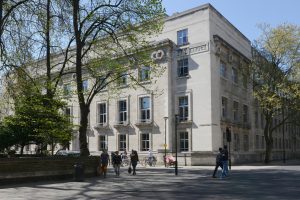Decorating the exterior of the London School of Hygiene & Tropical Medicine (LSHTM) is a frieze in the Art Deco style of gilded bronze figures of ten different animals. The figures are sculpted into the iron balconies on the first floor overlooking the front and sides of the building. All the animals represented can affect human health and well-being adversely. Most live in close proximity to man. Man provides the food and shelter these animals require to facilitate rapid population growth until they become pests.
Eight of the animals are arthropods and of these seven are insects – the flea, the tsetse-fly, the housefly, the bedbug, two types of mosquito, and the body louse – plus the tick which is an arachnid. One mammal is represented – the rat, and the reptiles are represented by a snake. The actual selection process that led to the particular choice of animals in the frieze is unknown. Eight are vectors that can transmit dangerous parasitic microorganisms to man causing diseases: at the School the sculptures of these eight are referred to as ‘the gilded vectors of disease’ (neither the snake is a vector nor, we now know, is the bedbug).
London School of Hygiene & Tropical Medicine, Keppel Street building from Malet Street
The purpose-built building in Keppel Street, Bloomsbury, was opened by HRH the Prince of Wales on 18 July 1929. Now Grade II listed (9 March, 1982), it is a steel-framed building with a Portland stone façade, designed in the stripped Classical style by the architectural partnership of Verner Owen Rees (1887-1966) and Percy Richard Morley Horder (1870-1944). The firm of J. Starkie Gardner Ltd., Decorative Metal Workers, of Southfields, made the iron balconies. The sculptures, which measure approximately 26 cm. high x 27 cm. wide (maximum) are sculpted into a pattern of grey iron squares measuring 28 cm. high x 27 cm. wide (outer edge). In total there are 30 sculptures arranged in pairs, each of the 10 figures repeated three times in different pairings. In life the insects and the tick measure less than 1 centimetre long. Here, for the sculptures, they have been greatly enlarged. In contrast, the cobra snake figure has been scaled down from the size of an adult, and the rat sculpture is approximately life-size. All the animal figures are somewhat stylized although most retain the essential characters for scientific identification to genus level. Responsibility for the frieze design is attributed to architect P.R.Morley Horder1.
Species of all the animals on the frieze live in the UK except for the tsetse-fly which is endemic in Africa and the Middle East and the particular snake represented – the cobra – which is found on the Indian subcontinent and in Africa. During World War I (1914-18) it was discovered that many soldier’s deaths arose not just from the actual conflict but from diseases contracted in the trenches and camps, spread by some of these animals. In Britain there were official campaigns to educate the public about the dangers these pests posed. The Natural History Museum in South Kensington printed eye-catching posters about three of them to aid identification and recommend methods for their destruction2. Despite the precautions, and the efforts by governments and pest controllers, 100 years on, all these animals are still with us and still present a threat to human health, their distribution and populations rising and falling, as environmental conditions and other factors change.
Insects comprise about half of all known living animals and display an unparalleled range of colours, shapes, sizes, and beauty. They can live anywhere in the world except the polar regions, yet, unlike some other animals, they have rarely been used in the decoration of public buildings (Ruthven 2011: 112-113, 118-119, back cover). Even the Natural History Museum, covered internally and externally with terracotta figures of fauna and flora, has few insects in the ornamentation. The presence of these arthropod figures on the LSHTM is unique in London for both variety and quantity displayed on one building: it prompted a remark at the time of the building’s opening that it must be “the first official appearance of the louse as a decorative emblem”3.
The following illustrated descriptions outline briefly the ten animals depicted – their life cycles and medical importance:
DEFINITIONS
Arboviruses. Arthropod-borne viruses. A virus that multiplies in an arthropod and is transmitted by its bite to a vertebrate host (Service 2012: 279)
Vector. A vector is an animal, usually an insect or a tick, that transmits parasitic organisms – and therefore the diseases they cause – from person to person or from infected animal to human beings. Mosquitoes, for example, are vectors of malaria, filariasis and yellow fever. (Concise colour medical dictionary. 3rd ed. (Oxford: Oxford University Press) 2002.
ACKNOWLEDGEMENTS
With thanks to staff at LSHTM: in the Library & Archives team: Claire Frankland, Aisling O’Malley, Manasseh Boyd; Eloise Carpenter; Gemma Bayliss; Professor James Logan, LSHTM Head of the Department of Disease Control and Director of ARCTEC; Paula Jenkins, Natural History Museum; Barry Hughes.
NOTES
- Percy Richard Morley Horder. https://en.wikipedia.org/wiki/Percy_Richard_Morley_Horder (viewed 4/4/2019). Despite an extensive search of the School Archives it has not been possible to confirm the identity of the designer of the sculptures.
- The Natural History Museum (then known as the British Museum (Natural History)) posters were issued in 1918, and 20,000 copies of each were printed, sold at one halfpenny each. One was on the fly. http://collection.sciencemuseum.org.uk/objects/co8093151/the-fly-danger-poster-united-kingdom-1918-poster (viewed 30/4/2019). The Museum put on an exhibition of wax models of arthropods of medical importance in 1916 and published an accompanying illustrated catalogue: Guide to the specimens and enlarged models of insects and ticks exhibited in the Central Hall illustrating their importance in the spread of disease (London, 1916; Special guide No. 7). A second edition was published in 1919. The exhibition was on public display at least until the mid-1920s.
- Quoted in G.C. COOK (1992) From the Greenwich hulks to Old St Pancras. A history of tropical disease in London (London: The Athlone Press), pp. 249-250; from: ANONYMOUS (1929) ‘Preventive medicine in London: the new School of Hygiene and Tropical Medicine’, Lancet 1929 ; ii : 148-150.
REFERENCES AND FURTHER READING
BARNETT, S. Anthony (2001) The story of rats. Their impact on us and our impact on them (Crows Nest, NSW, Australia: Allen & Unwin) Pp.xiii, 202.
BURGESS, N.R.H. (1990) Public health pests. A guide to identification, biology and control (London: Chapman and Hall) Pp. xi, 162.
BURGIN, C.J. (2017) Species accounts of Muridae. Pp. 829-831 in: WILSON, D.E., LACHER, T.E., Jr. and Mittermeier, R.A. (eds) Handbook of the mammals of the world. Vol. 7. Rodents II (Barcelona: Lynx Edicions)
HINTON, M.A.C. (1931) Rats and mice as enemies of mankind. 3rd ed (London: British Museum (Natural History)) Pp. x, 70. https://www.biodiversitylibrary.org/bibliography/86373#/summary (viewed 1/5/2019)
MORRIS, Ramona & MORRIS, Desmond (1965) Men and snakes (London: Hutchinson) Pp. 224.
REES, Verner O. & HORDER, P. Morley, 1929. London School of Tropical Medicine, The Architects’ Journal 70 (No. 1800): 84-89.
RUTHVEN, Ianthe, 2011. Animal London: a spotter’s guide. (London: Square Peg). Pp. 172.
SERVICE, Mike (2012) Medical entomology for students. 5th edition (Cambridge: Cambridge University Press). Pp. xx, 303.
WILKINSON, L. & HARDY, A. (2001) Prevention and cure. The London School of Hygiene and Tropical Medicine. A 20th century quest for global public health (London, &c: Kegan Paul). Pp. [6], 438.
THE GILDED VECTORS OF DISEASE. Wonders of science! Bizarre histories! Real & true facts! Amazing creatures. (2013). Produced by Rebecca Tremain & Rob Falconer. (The Mustard Club in association with London School of Hygiene & Tropical Medicine). Original series first broadcast on Resonance FM Radio 4 April to 23 May 2012. Two disc Collector’s Edition. Highlights from the Radio Series.
IMAGES
© LSHTM ‘Keppel Street building from Malet Street’
© User:Colin / Wikimedia Commons CC BY-SA 4.0 https://commons.wikimedia.org/wiki/File:Gilded_Vectors_of_Disease_-_Horizontal.jpg
















